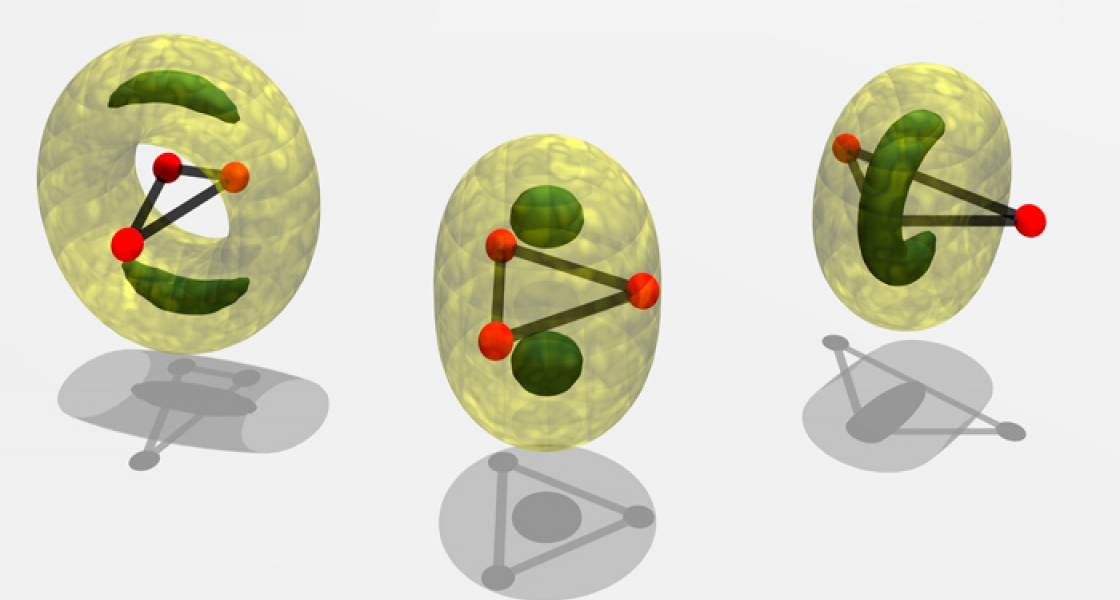The most peculiar and fragile "molecules" ever discovered are the weakly bound triatomic Efimov molecules that form under specific conditions in a Bose-Einstein condensate (BEC). JILA theorists have now shown that such molecules can interact with an additional atom to form "daughter" molecules, which inherit many of their mother’s characteristics.
What's strange is that the atoms in a BEC mostly feel no force of attraction to each other. In fact, the atoms only feel attracted to one another when they are right on top of each other. Even so, any three of them can still stick together in an infinite number of quantum states. This strange behavior is due to a kind of memory "ghost" created by the attraction that the atoms experience when stacked on top of each other. This eerie memory allows three (but not two) atoms to form an infinite number of fragile molecules, or bound states — even when they are relatively far apart.
Curiously, weakly bound triatomic Efimov molecules are quite different from garden-variety molecules. They form very floppy triangles in which the three atoms can have virtually any geometric relationship with one other. Vitaly Efimov predicted these bound states in 1970. During the late 1990s, Fellow Chris Greene’s group (with J. P. Burke Jr. and Brett Esry) and others explored and expanded a theory of Efimov physics. Greene’s group was eventually able to predict the conditions under which triatomic Efimov molecules could be observed experimentally; their efforts were rewarded in 2006 when Rudi Grimm’s group at the Universität Innsbruck found them in the laboratory.
A year or so afterwards, graduate student Javier von Stecher (now a postdoc with Fellow Ana Maria Rey) began to wonder what would happen if you added another atom to the system. In other words, would an Efimov quartet form? What would it look like? How would it behave?
It took von Stecher, senior research associate José D’Incao, graduate student Seth Rittenhouse, former postdoc Nirav Mehta (now at Grinnell College), and Greene more than a year to develop the analytical tools needed to answer these questions. When they succeeded, the researchers became the first theorists to model the behavior of four interacting ultracold particles that recombine.
D’Incao and von Stecher then reviewed the 2006 experimental data from the Universität Innsbruck and discovered a peak exactly where the new theory predicted the appearance of one of the quartets. Upon hearing this news, the Grimm group immediately undertook a new experiment designed to search for both Efimov quartets. The Austrian group not only found strong evidence for both of them, but also was able to measure the rate at which four atoms simultaneously collide and form molecules.
The recent spate of theoretical and experimental successes with Efimov physics has opened the door to creating and investigating Efimov molecules in an ultracold quantum gas of atoms. Greene says it’s just a matter of adjusting the magnetic field. He would like to see an experimental group pick up this ball and run with it. - Julie Phillips



 The Physics Frontiers Centers (PFC) program supports university-based centers and institutes where the collective efforts of a larger group of individuals can enable transformational advances in the most promising research areas. The program is designed to foster major breakthroughs at the intellectual frontiers of physics by providing needed resources such as combinations of talents, skills, disciplines, and/or specialized infrastructure, not usually available to individual investigators or small groups, in an environment in which the collective efforts of the larger group can be shown to be seminal to promoting significant progress in the science and the education of students. PFCs also include creative, substantive activities aimed at enhancing education, broadening participation of traditionally underrepresented groups, and outreach to the scientific community and general public.
The Physics Frontiers Centers (PFC) program supports university-based centers and institutes where the collective efforts of a larger group of individuals can enable transformational advances in the most promising research areas. The program is designed to foster major breakthroughs at the intellectual frontiers of physics by providing needed resources such as combinations of talents, skills, disciplines, and/or specialized infrastructure, not usually available to individual investigators or small groups, in an environment in which the collective efforts of the larger group can be shown to be seminal to promoting significant progress in the science and the education of students. PFCs also include creative, substantive activities aimed at enhancing education, broadening participation of traditionally underrepresented groups, and outreach to the scientific community and general public.